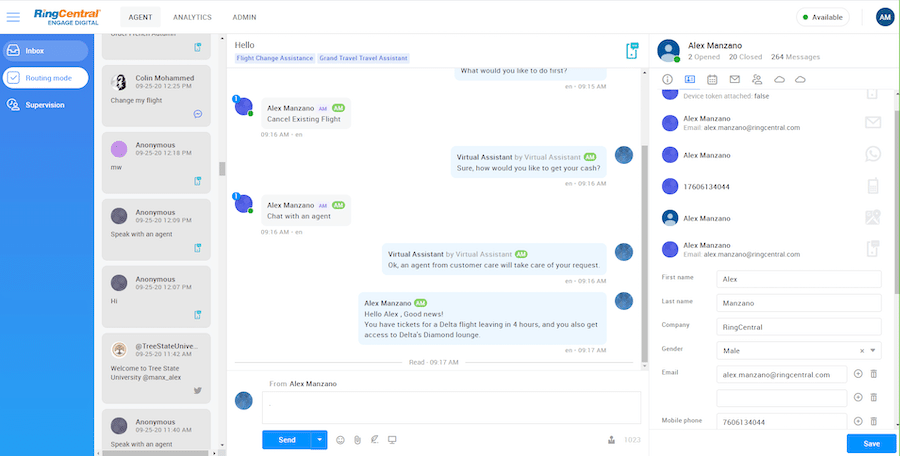If you need info on how to grow a small business, here’s a hard truth: only 50% of small businesses survive beyond five years.1
Also fact: you’re reading this because you’re determined to avoid that fate and succeed where other small business owners haven’t.
As a small business owner, every little problem is yours to solve, every failure is your fault, and every success gives everyone but you an excuse to celebrate. The bottom line is, when you decide to start and grow your business, it’s a 24/7/365 commitment that requires an enormous amount of physical, mental, and emotional effort.
But effort alone won’t reap the reward of business growth. You know that just as much as we do. Your small business growth relies on a multitude of things working efficiently and effectively—not only on their own, but also together in unison. It’s not as easy as some business blogs like to make it seem.
And that’s what we set out to do differently here in this post. We’re not just going to list the various business growth stages and how to reach and surpass them—we’re going to give you specific action items to start working on so you can experience true, long-lasting business growth.
In this post, we’ll dig into:
- Understanding the 5 growth stages of a small business
- How long it takes to grow a business
- 9 ways to grow your small business
🔑 Customer service is essential to a strong small business. Does your team have what it takes to keep people coming back?
Understanding the 5 growth stages of a small business
According to the Harvard Business Review, there are five distinct stages in the life cycle of a small business:2
- Existence: generating customers and fulfilling their orders
- Survival: breaking even and generating cash flow
- Success: to grow or to enjoy stable profitability? The choice is yours
- Take-off: growing fast…and finding ways to finance it
- Resource maturity: taking control and remaining entrepreneurial
Where does your business fall today? Whatever the case, the following information could help you take better advantage of your current growth stage… and maybe even push you to the next level.
How long it takes to grow a small business
We hope you’re not starting a small business on a whim thinking it’s going to generate massive gains in year one.
Or year two.
And maybe even year three.
That’s because it typically takes about a year or two for small business owners to nail down the fundamentals of their company.7 Not make money or even break even. Just nailing down the fundamentals.
Not only do you have to find and lease a piece of property, procure vendors, and hire staff, but you also have to legally register your company, decide on a name and brand, and set up any integrated communications tools you may need.
And as for growth? We’re talking about reaching profitability maybe during year two or three.8 And that’s on average.
But you don’t want to be an average small business owner, do you?
If not, then keep reading, because the next three sections are dedicated to you and your small company’s accelerated growth timeline.
9 ways to grow your small business
1. Hire competitive self-starters to your sales team
This might seem like a silly thing to lead with when talking about sales, but at the end of the day, the only people who sell well are those who are willing to persevere through challenges and grind it out until they become successful.
That’s because prospecting, sales funnel tactics, and cold call scripts are only as good as the person you give them to. In other words, focus on who you hire before you focus on other things like where they went to school and their qualifications.

2. Know your target audience and their pain points
First, you need to observe competitors and small businesses that look like you to see what your target audience physically looks like, how they act, what they dress like, what they do for a living, so on and so forth.
From there, it’s time to uncover your target audience’s pain points. It doesn’t matter if you’re selling pizzas or massages, your clients and customers have pain points that need to be relieved.
Now, what these pain points are and figuring out what it is about your product or service that makes them feel better—in other words, knowing why people get pizzas or massages at a given time—can give you all the ammunition you need to begin tapping into people’s emotions with strategic sales messaging. And that’s at the heart of not just sales, but also providing excellent small business customer service.
🕹️ Get a hands-on look at how RingCentral is designed for fast-growing small businesses by booking a product tour:
💰 You can also use this calculator to see roughly how much your business could save by using RingCentral to support your team’s communication with each other—and clients.
3. Set realistic yearly and quarterly sales goals
Goals are great because goals are actionable. They help you see where your company is today and where it could be three, six, nine, and 12 months from now.
Setting goals grounds your sales process and gives you a singular target—something you can zero in on and put all of your small company’s energy and resources towards.9 At the same time, goals will inspire you to constantly measure sales efforts to discover what is and isn’t working for your team. This can be hugely helpful in coming up with new techniques and strategies, or even uncovering a new audience segment that you hadn’t yet considered.
Of course, you’ll be setting goals at all company growth stages, but getting them down on paper during the early stages of business development sets the tone for you and your team and serves as something for you to live up to.
4. Marketing: optimize your website for SEO and start writing a blog
It’s simple and sounds way easier than it is, but investing in your small business’s website and utilizing AI writing to produce blog articles regularly can be the difference in major revenue growth over the course of your company’s life cycle.
That’s because the more SEO-friendly content you create on your site, the more search engines like Google are going to favor your website when internet users search for things related to your business. The more Google favors your site, the more people will see your brand, click on your website, and consume your content.
And the more people consume your informative and helpful content, the more likely they are to buy from you. That’s what your website and blog are ultimately designed to do: inform and help your customers. If you do that successfully, you’ll be busier than you could imagine.
5. Build a social media following on Facebook, Instagram, and LinkedIn
Say what you will about social media—it can absolutely help your small business grow.10 In fact, it’s another no- or low-cost way of marketing your company and spreading the word about your products or services.
We suggest setting up pages on Facebook, Instagram, and LinkedIn. This way, your company has a presence on three of the major social media platforms.
But it’s not merely enough to have social media profiles—you need to post, too! Early on, do your best to educate yourself on each of the social media channels, the types of content you should post on them, and how often you should post in order to gain followers, drive engagement, and maximize your efficiency on the platforms.
If you’re on three or four different social media channels, then you should have some kind of social CRM or tool that consolidates all these conversations into one handy place so you don’t have to constantly toggle between different windows and tabs.
6. Create a unique, memorable experience around your product or service
One way to grow your small business through marketing is to create something unique about your brand experience.
Whether you offer a product or a service, attaching an unexpected, never-before-seen element to it can be effective in planting a memory of your company into the hearts and minds of consumers. Not only that, but customers and clients who are delighted by a unique experience you provided them will begin to tell your brand story to their friends and community, building awareness and intrigue for your small business.11
Although there are plenty of ways to create a unique and memorable experience to help your small business grow, a few quick and easy ones are:
- Give random coupons and deals to customers
- Get space on a local billboard and design a humorous ad
- Gamify the shopping experience at your store or restaurant
- Implement a standard way of doing things for all employees that customers and clients will notice and admire
- Give your place of business a specific look and feel (e.g., 60s design, 60s music, 60s television)
7: Make customer service your point of pride
To experience growth and success through all stages of a business, one thing should always be operating at a top-notch level, and that’s your customer service.
Big corporations can get away with shoddy customer service, but as a small business owner, you simply cannot. A customer-centric team is critical to growing and maintaining your base.
These days, it only takes one bad experience for a customer to write a horrible review online that could jeopardize the livelihood of your company. It’s sad but true. That’s why it’s important to look at customer service—not as an annoying thing you have to do, but as a business-building asset you want to do.
At the end of the day, customer service is many things and comes in many forms. Yet one thing is true: great customer service is memorable and can help your small business experience significant growth.
One way to narrow your customer service focus and really generate some attention is to make just one aspect of it your focus.
Do you want to be known as the most responsive small business in your area? The fastest to respond? The friendliest with their responses?
Whichever route you choose, it’s important that you and your team agree upon one singular goal and start doing everything in your power to accomplish that. Before long, you’ll have five-star reviews online and people all around town talking about your customer service, which will only mean good things for your business.
8. Equip your service team with the best communications technology
If your small business relies on a more traditional customer service setup, then it’s imperative that your team is well-equipped with the best software and communication tools.
The last thing you or your customer service team needs to deal with are bandwidth issues and faulty tech when handling a customer call. Those moments are vital for showing your customers that you prioritize them—after all, they’re paying you, so they better be your top priority.
Small business call center software gives your customer service reps the confidence to simply do what they do best: handle customer inquiries and complaints with patience and genuine care. If they’re able to do that, then your customers will be happy, and your small business will be another step ahead of the competition.
Oh, and if you receive a lot of messages from customers over the phone, email, and digitally on social media—but still want to keep your tools streamlined—RingCentral has an Engage Digital platform that can merge these conversations:
For instance, if someone messages you on Facebook, then Tweets at you and/or messages you on Instagram, you can see all of those in one convenient thread:
9. Use proactive customer service to drive customer loyalty
If you can afford to do it, we recommend implementing a proactive customer service strategy.
With this, you’ll be doing things like actively reaching out to existing customers to get feedback on their experiences with your company (as opposed to waiting for them to come to you when they have problems). To encourage their responses, you can always offer these customers coupons or deals on their next purchase.
The key here is the “proactive” part—you have to reach out before problems arise. This way, you can build more positive moments into your customer experience.
By doing this, you’re also accomplishing a few different things:
- Showing customers you care about them
- Getting valuable feedback on your product, service, and brand
- Guaranteeing repeat purchases from at least some of these customers
- Likely inspiring some of these customers to tell their friends and family about your business
- Empowering your customer service agents to look at their jobs differently
It’s a totally transformative way of doing customer service and one that could prove decisively effective in growing your small business.
Ready to start growing your small business today?
We’re confident that if you take these actionable tips and start doing these things at your company, you’ll discover a new level of growth that you haven’t yet experienced at your small business.
Whether you begin with sales, marketing, or customer service, growth is always possible—it all comes down to you investing the time and effort into the things we’ve written about in this blog to move your company to the next growth stage of business.
And when you do, let us know. We’d love to hear about your success story.
1fundera.com/blog/what-percentage-of-small-businesses-fail
2, 3, 5hbr.org/1983/05/the-five-stages-of-small-business-growth
4corporatefinanceinstitute.com/resources/knowledge/finance/business-life-cycle
6forbes.com/sites/lizryan/2018/01/27/why-company-culture-goes-bad-and-how-to-fix-it
7freshbooks.com/hub/startup/how-long-does-it-take-business-to-be-successful
8smallbusiness.chron.com/average-time-reach-profitability-start-up-company-2318.html
9leadforensics.com/why-is-it-so-important-to-set-sales-targets
10blog.hootsuite.com/social-media-tips-for-small-business-owners
11socialmediatoday.com/marketing/3-reasons-let-customers-tell-your-brand-story
Originally published Nov 10, 2020, updated Aug 22, 2023






